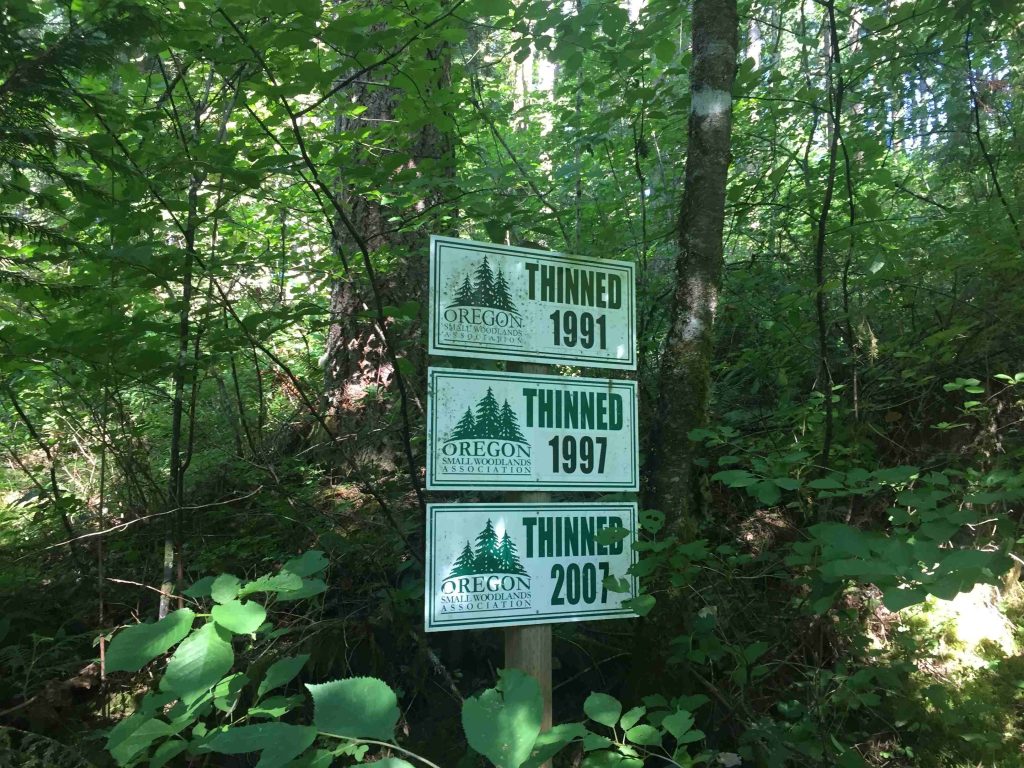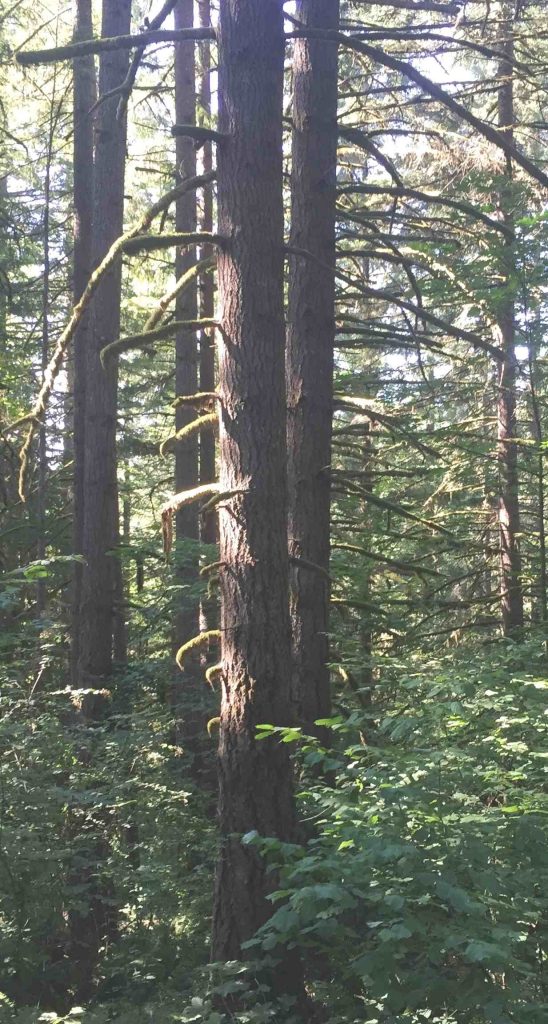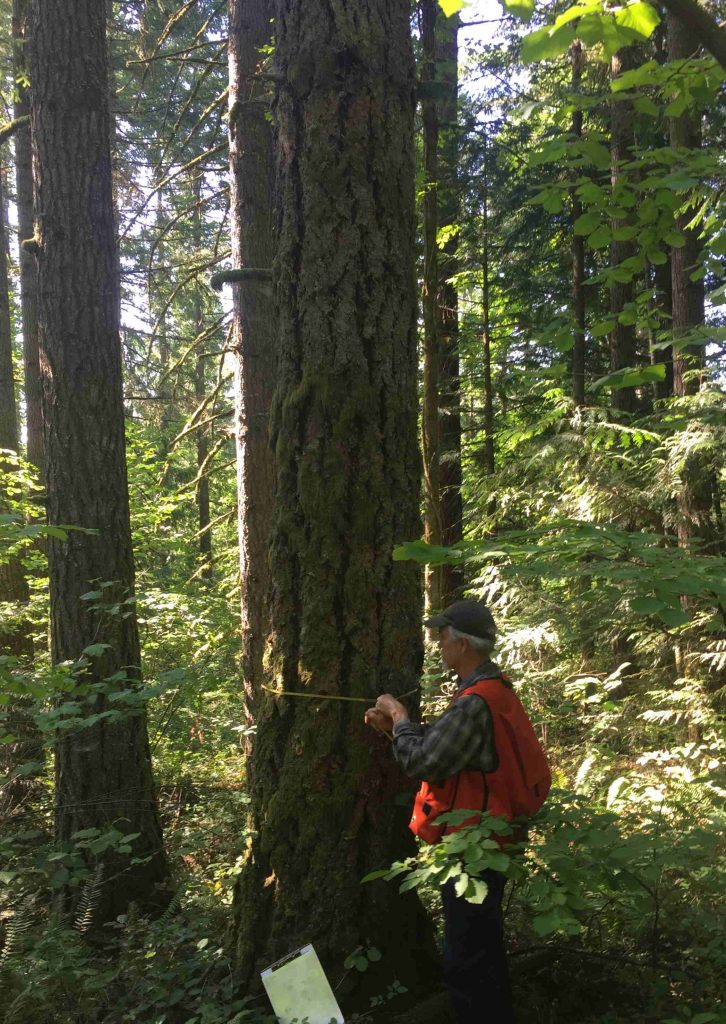Glenn Ahrens, OSU Forestry and Natural Resources Extension Agent – Clackamas, Marion, and Hood River Counties
Many family forest owners I meet have older trees and forests – 60 to 80 or more years old – and they would like to retain mature forest conditions. They are interested in periodic thinning, selective harvesting of trees or small patches, and keeping options open for the future. But landowners with larger older timber often hear that they are better off, from an economic and operational standpoint, to clearcut a patch and regenerate it all at once.
Clearcutting is efficient. Douglas-fir regenerates best in a clearing with lots of sun. If trees get too big, local markets for large logs may be limited…etc. But if you want to grow and retain mature forest characteristics, what are the options for managing older Douglas-fir forests with thinning and selective cutting rather than larger clearings?
We seek some answers to this question in our management of several demonstration areas at Hopkins Demonstration Forest. For example, our prominent “Hillside Forest” is about 25 acres of 80-90 year old second-growth forest that we have thinned three times since 1991. In this mature forest, a clearcut harvest to regenerate a new stand would be an effective, economically efficient harvest and regeneration method. It would help meet our ongoing need for revenue. On the other hand, Douglas-fir and western redcedar can be vigorous and productive for centuries and we can continue to generate some revenue with periodic thinning. So, we are re-considering the options and revising the management plan, seeking to clarify our objectives and develop a long-term strategy for the Hillside Forest.

After almost 30 years of management at Hopkins Demonstration Forest, we are taking stock of what we have learned about the challenges and benefits of thinning and selection cutting. Among the challenges are:
• Risk of damaging soil and trees due to repeated entry with machines in the forest.
• Introduction or stimulation of invasive weeds such as blackberry, geranium, etc.
• Competition from understory vegetation after thinning.
• High level of skill needed to fell large tall trees without excessive damage – to them or the trees being retained for the future.
• Need for permanent roads and skid trails throughout the stand in order to access the whole area for periodic thinning or selective removal.
• Risk that once trees are older and larger, you may be compelled (personally or socially) to protect them, thus reducing actual harvest rate from what was planned.
• Buyers for large logs from older trees are fewer and often farther away.
• If large limbs (knots) are allowed to develop, value is significantly degraded on big trees.

On the plus side, some potential benefits of continued thinning and selective cutting include:
• Enjoying mature forest conditions, large trees, diverse species and layers, wildlife habitat, aesthetics, etc.
• Capturing some of the timber value for periodic income while increasing percentage growth rate in thinned stands.
• Avoided or reduced reforestation costs; avoided risks of regeneration failure.
• Maintaining healthy tree crowns and future options (to keep thinning)
• Producing some trees with higher value large sawlogs, poles, or veneer (if we get it right).

At Hopkins Demonstration Forest, we are in the process of addressing these challenges and pursuing the potential benefits. This fall we will be looking at the Hillside forest with some tried-and-true loggers to get their input on operational aspects. Our Forest Management Committee is looking at the current forest conditions and key questions such as:
Does it “need” thinning? Based on objective guidelines using average size of trees and number of trees per acre.
What is our current timber quality, log size, and log grade breakdown?
How do you manage maturing forests to produce higher quality stems and avoid degrade due to “oversize” diameter and large limbs?
How much of the ground is occupied by brush and hardwoods – how much is too much? What will it take to prevent excessive brush and invasive weeds after harvesting?
What are the trade-offs in costs and revenues for thinning vs. patch clearings?
Stay tuned for some answers in future articles on this topic. If you are interested in learning and sharing your knowledge about managing mature forests, please join us in our effort at Hopkins Demonstration Forest. Let me know if you are interested in helping with inventory, assessment, tree marking, and other tasks as we continue to study and manage the Hillside forest. glenn.ahrens@oregonstate.edu

See our Upcoming Events list to look for classes or field tours sharing results of what we have learned so far. Also, check out the Extension publications in our Alternative Forest Management Series highlighting other case studies of thinning and selective management of mature forests in Oregon.
